Harmony is the backbone of melody, and when you aim to evoke sadness and deep emotion in your music, understanding and utilizing Sad Guitar Chords and chord progressions is essential.
A chord is formed when multiple notes are played simultaneously, creating a richer sound than a single note. A chord progression is simply a sequence of chords played one after another. Certain chords naturally carry a somber or melancholic tone, while others can be woven into progressions to create a feeling of sadness, even if they sound brighter on their own. In this guide, we will delve into five distinct guitar chords known for their sad qualities and explore five chord progressions that effectively convey emotional depth.
Minor vs. Major: The Foundation of Emotion in Chords
Generally, major chords and progressions are associated with feelings of happiness and upliftment, while minor chords and progressions tend to evoke sadness. This is a useful starting point, but it’s not a rigid rule. As we’ll see, major chords can also contribute to a sad atmosphere within the right progression and context.
What Makes a Guitar Chord Sound Sad?
Several musical elements contribute to a chord’s sad or melancholic quality:
- The Minor Third Interval: This is arguably the most crucial element. The difference between a major and minor chord lies in the third interval. A minor third, compared to a major third, creates a darker, more introspective sound.
- Dissonant Intervals: Chords containing dissonant intervals – intervals that create tension and instability – often sound sad or uneasy. These intervals add complexity and emotional depth.
- Lower Voicing: Playing chords in a lower register on the guitar, closer to the neck, generally produces a darker and heavier sound, enhancing the feeling of sadness.
- Open Strings: The resonance of open strings can add a layer of vulnerability and rawness to chords, which can contribute to a sadder overall tone.
The following five sad guitar chords incorporate one or more of these elements to achieve their emotional impact.
-
D Minor (Dm)
The D minor chord is a foundational sad chord. It features a minor third interval and is typically played with open strings and in a lower voicing, making it inherently melancholic. While it doesn’t contain dissonant intervals, its other qualities firmly place it in the category of sad chords.
Created with Guitar Pro
-
D Suspended 2nd (Dsus2)
Suspended chords replace the third interval of a triad with either a second or a fourth. The Dsus2 chord substitutes the third with a second, creating a dissonance that adds a unique, unresolved quality. Both sus2 and sus4 chords have this dissonant characteristic, but sus2 chords often lean towards a sadder, more yearning sound.
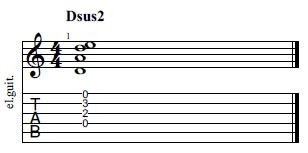 Diagram of Dsus2 guitar chord
Diagram of Dsus2 guitar chord -
A Minor Add 9 (Am add9)
Adding a major 9th interval (which is the same as a 2nd interval, but an octave higher) to a minor triad introduces dissonance and expands the harmonic texture. In Am add9, the 9th interval is added to the existing A minor triad, without replacing the minor third. This combination of the minor third and the dissonant ninth contributes to the chord’s poignant and sorrowful character.
-
B Minor 7 Flat 5 (Bm7(b5))
The Bm7(b5) chord, also known as a half-diminished 7th chord, is harmonically rich and complex. It’s commonly found in minor keys and possesses a distinctly empty and somber sound. This chord type is frequently used to create a sense of unease or melancholy, and it features prominently in the second sad chord progression we’ll explore.
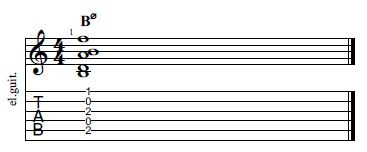 Diagram of Bm7(b5) guitar chord
Diagram of Bm7(b5) guitar chord -
E Minor 9 (Em9)
The Em9 chord goes a step beyond the minor add 9 by including the seventh degree of the scale in addition to the ninth. This further increases the dissonance within the chord. However, instead of pure sadness, Em9 often evokes a more complex emotion – a sense of tension, foreboding, or uneasy anticipation. It suggests not just sadness, but a feeling that something unsettling is about to occur.
Emotional Chord Progressions: Weaving Sadness Through Harmony
While individual chords possess inherent emotional qualities, their impact is amplified when placed within a chord progression. Even chords typically considered “happy,” like major chords, can contribute to a sad feeling when used in specific sequences.
The following five chord progressions are effective tools for expressing sadness in your guitar music. A basic understanding of diatonic chord progressions and Roman numeral analysis (where Roman numerals represent the chord’s function in a key) will be helpful in understanding these examples.
-
i – VI – v in A Minor: Am – F – Em
Starting with the minor key is a direct path to conveying sad emotions, and this progression in A minor is a classic choice for creating a depressing and melancholic mood. The movement from the tonic (i) to the major VI and then to the minor dominant (v) creates a sense of downward emotional pull.
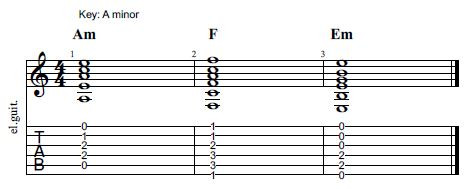 Chord diagram for Am-F-Em progression
Chord diagram for Am-F-Em progression -
i – ii min 7 (b5) – v – i in D Minor: Dm – Em7(b5) – Am – Dm
This progression, entirely built from minor and diminished chords in D minor, intensifies the feeling of sadness. The inclusion of the ii min7(b5) chord (Em7(b5) in D minor) adds a significant layer of harmonic tension and darkness, making it difficult to achieve a happy or uplifting sound with this sequence.
-
I – iii – IV – V in C Major: C – Em – F – G
While songwriters often gravitate towards minor keys for sad music, major key progressions can also express unhappiness. This progression in C major utilizes three major chords and one minor chord (Em). The crucial element here is the move from the tonic (C) to the mediant (Em). This specific transition, moving from a stable major chord to a minor chord on the third degree, is surprisingly effective at creating a melancholic feeling even within a major key context.
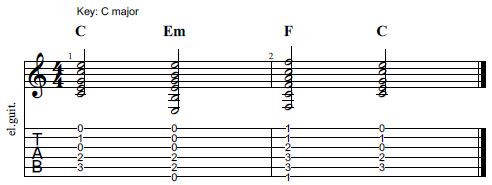 Chord diagram for C-Em-F-G progression
Chord diagram for C-Em-F-G progression -
I – vi (add9) – IV in C Major: C – Am add9 – F
Another technique for adding sadness to major key progressions is to incorporate extended chords or additions to basic triads. This progression in C major uses the Am add9 chord (vi add9). The added 9th in the Am add9 chord introduces a touch of dissonance and complexity, darkening the overall mood of the progression and adding emotional depth.
-
IV – iv – I in A Major: D – Dm – A
This progression, despite being rooted in A major, employs a technique called modal mixture or borrowed chords. It borrows the iv chord (Dm) from the parallel minor scale of A minor. In A major, the IV chord is D major, but by using D minor instead, the progression takes on a significantly sadder character. This progression is also known as the minor plagal cadence and is a powerful way to inject melancholy into a major key.
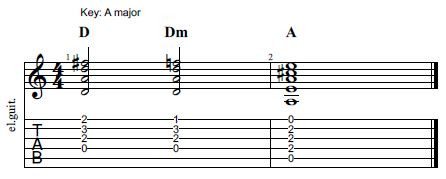 Chord diagram for D-Dm-A progression
Chord diagram for D-Dm-A progression
Beyond Chords: Crafting Truly Emotional Music
While choosing sad chords and progressions is a crucial step, writing genuinely sad and emotional music involves considering a broader range of musical elements. Harmony is only one piece of the puzzle.
Here are additional elements to consider when composing sad and emotional guitar music:
- Tempo: Opt for a slow tempo. Slower tempos generally create a more somber and reflective mood, allowing the emotional weight of the chords to resonate.
- Melody: Use longer, sustained notes in your melodies. Legato phrasing and longer note values contribute to a more melancholic and drawn-out emotional expression.
- Scales: Explore scales that naturally convey sad emotions, such as the harmonic minor scale or the natural minor scale. These scales contain intervals that lend themselves to minor and melancholic harmonies and melodies.
- Phrasing Techniques: Utilize expressive guitar techniques like string bending and vibrato. These techniques add human-like vocal qualities to your playing, enhancing the emotional impact and vulnerability of the music.
- Dynamics: Keep the overall dynamics soft and restrained. Piano and mezzo piano dynamics are conducive to sadness. However, strategically placed accents can create emotional climaxes and moments of heightened intensity within a generally soft dynamic landscape.
- Lyrics: If your music includes vocals, ensure your lyrics align with the sad and emotional tone you’re aiming for. Lyrics are a powerful tool for conveying specific narratives and emotional states.
By mastering sad guitar chords and progressions and thoughtfully incorporating these additional musical elements, you can create deeply moving and emotionally resonant guitar music.
If you find value in this lesson, consider supporting music education and independent content creation. Your contribution, however small, helps sustain resources like this and encourages the creation of more music learning materials.
Share this lesson with fellow guitarists and music enthusiasts!


